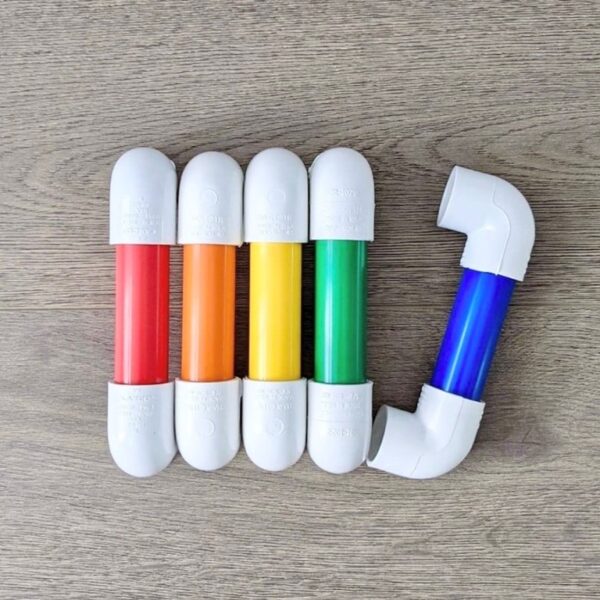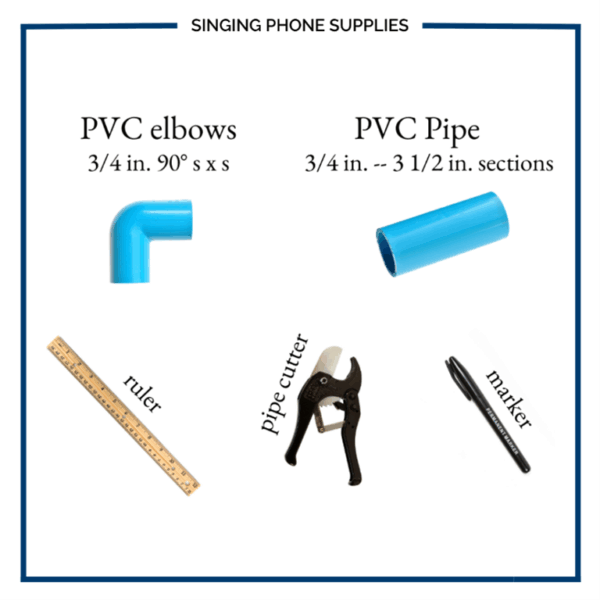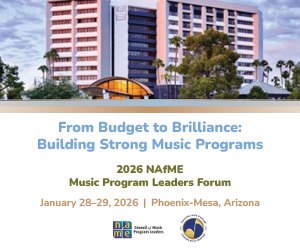/ News Posts / Singing Phones: A DIY Project for Elementary Music Teachers
Singing Phones
A DIY Project for Elementary Music Teachers
By NAfME Member Jennifer Hibbard
Do-it-yourself projects are often a necessity in elementary music classrooms, where limited budgets must serve an entire student population. Sometimes this means making enough items for 500 or more students on a budget of $50 or less. Perhaps this explains why blog posts featuring DIY projects, such as Old Mister Rabbit and Puffball Rhythm Monsters, are so popular among elementary music teachers. When a project is both budget-friendly and fun, it’s sure to be a hit with music teachers and students alike.
Whisper phones are one example of a budget-friendly and fun classroom tool. They are used in elementary English-language classes to help students improve sentence fluency, enunciation, and volume. Made from PVC pipe, they are extremely durable and easy to sanitize. Given that music is a language, it is unsurprising that music teachers have adapted these tools for their own classrooms. Whisper phones, or singing phones, can be used to help with pitch matching, dynamic control, and diction.
What You’ll Need
- ¾ inch PVC Pipe cut into 3 ½ inch sections (10 ft. will make about 30 phones)
- ¾ inch PVC 90° Elbows S x S (2 for each phone)
- PVC Pipe Cutter
- Ruler
- Marker
You can try asking your local hardware store or your school’s shop class teacher to cut the PVC pipe into 3 and ½ inch sections for you. If they agree to do this, you won’t need the pipe cutter or ruler.
Assembling Your Phones
- Use the ruler to mark your PVC pipe into 3 and ½ inch sections.
- Cut the pipe using your pipe cutter. PVC pipe can be extremely difficult to cut depending on the quality of your cutters, so be sure to have a strong helper nearby if necessary.
- Attach an elbow to each end of the pipe, and you’re finished!
Additional Note:
- When attaching the elbows, ensure the smooth end is facing outward. Some elbows have plastic snags that a student could easily catch on their ear or hands.
Phone Cleaning and Maintenance
For a quick clean between uses, you can use sterisol just as you would any instrument. For a deep clean, you can run the singing phones through the school’s dishwasher, like you would plastic recorders. Other than keeping the phones clean, there’s no other maintenance required.
Using Your Phones
As mentioned earlier, these phones can be used to help students match pitch, improve diction, and control dynamics. Here are a few more ideas to consider:
- Have students use the phones while singing partner songs. Try pairing Frère Jacques with Three Blind Mice for a fun and easy partner song.
- Practice singing rounds with the phones. Scotland’s Burning and Music Alone Shall Live are two good options.
- Use the phones to practice inner hearing. To do this, have students cover up or underline one word on a song sheet. They will sing through the song as usual, but will sing the covered word in “their mind’s ear only”.
- Try using the phones as an extra incentive during whole-class instruction. For example, you could start by passing phones out to students who are displaying good singing posture. This is an easy and quick way to encourage other students to follow suit.
Updated August 11, 2025; originally published December 17, 2017.
About the author:
 NAfME member Jennifer Hibbard is the founder of Yellow Brick Road Music, where she creates fun music education resources for serious music literacy. Jennifer holds a Bachelor of music education degree (K-12 general, vocal, and instrumental music). She also holds a Master of education degree (curriculum and instruction). Her teaching experience includes K–4 general music, 7–12 instrumental music, as well as private vocal and instrumental lessons.
NAfME member Jennifer Hibbard is the founder of Yellow Brick Road Music, where she creates fun music education resources for serious music literacy. Jennifer holds a Bachelor of music education degree (K-12 general, vocal, and instrumental music). She also holds a Master of education degree (curriculum and instruction). Her teaching experience includes K–4 general music, 7–12 instrumental music, as well as private vocal and instrumental lessons.
Her professional affiliations include membership in the National Association for Music Education, the National Education Association, the Indiana Music Educators Association, and The Music Crew, a nonprofit organization dedicated to supporting music educators through free professional development and curated instructional resources. Her work has been published in NAfME’s Teaching Music magazine and blog. She is also a regular presenter at The Music Crew’s annual conference. Visit her website and follow her on Facebook and Instagram.
Did this blog spur new ideas for your music program? Share them on Connect! Interested in reprinting this article? Please review the reprint guidelines.
The National Association for Music Education (NAfME) provides a number of forums for the sharing of information and opinion, including blogs and postings on our website, articles and columns in our magazines and journals, and postings to our Connect member portal. Unless specifically noted, the views expressed in these media do not necessarily represent the policy or views of the Association, its officers, or its employees.
Published Date
August 11, 2025
Category
- Innovation
Copyright
August 11, 2025. © National Association for Music Education (NAfME.org)






